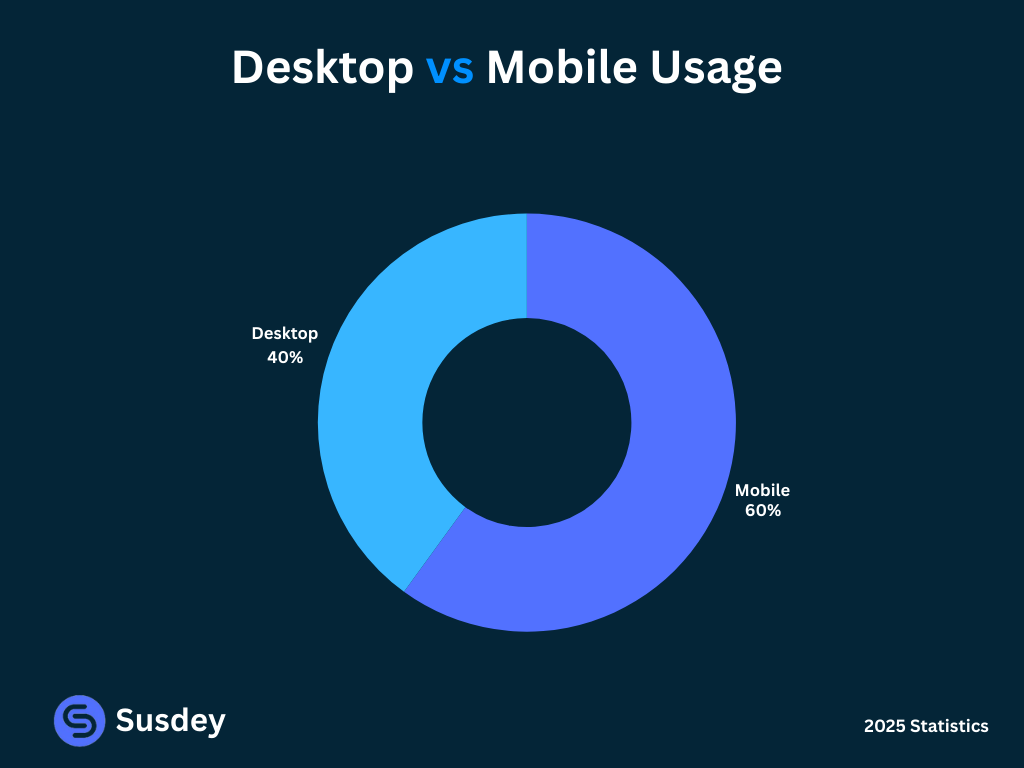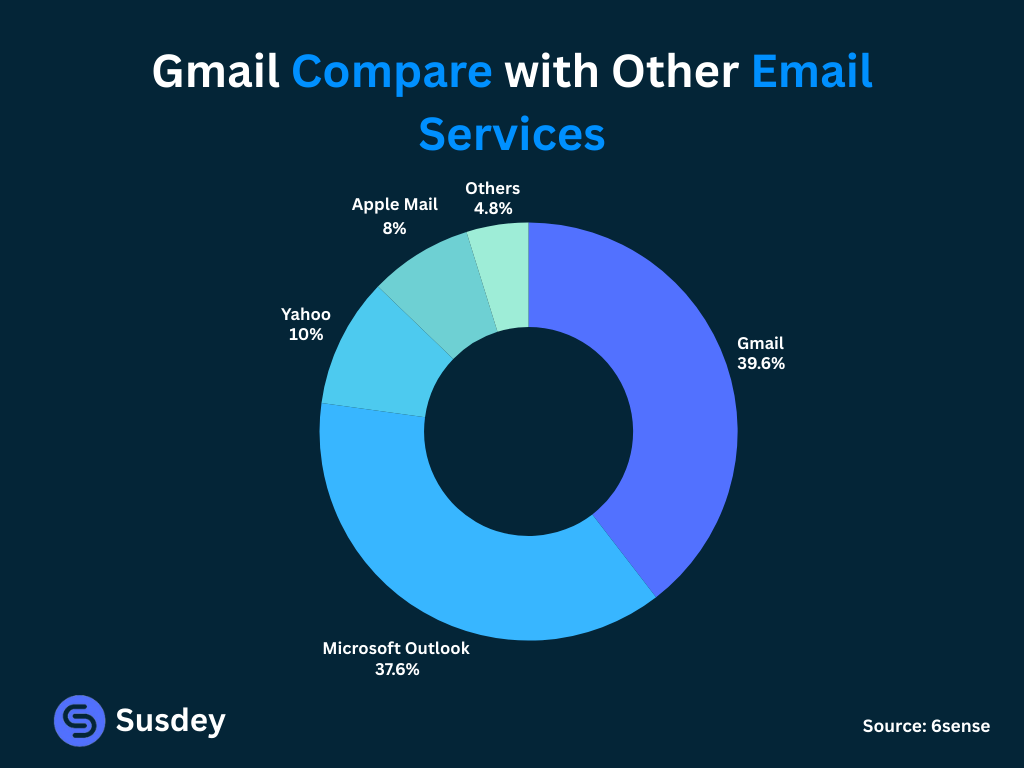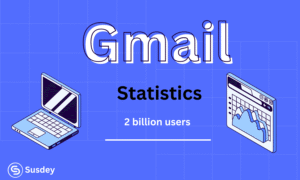Gmail is one of the most widely used email services worldwide, with billions of active users daily. It handles millions of messages every minute and remains a key tool for both personal and professional communication. Understanding its statistics reveals how people use email and how Gmail stands out among competitors.
The data on Gmail’s user base, email volume, and security measures help explain why it continues to grow and adapt. Knowing these numbers can give insight into email habits and the service’s impact on digital communication.
Gmail Statistics Quick Facts:
- Gmail boasts over 2 billion active users globally, accounting for approximately 22% of the world’s population.
- Gmail holds a 39.61% share of the global email client market, making it the second most popular email client after Apple Mail.
- Approximately 90% of startups and over 60% of mid-sized companies in the U.S. utilize Gmail for email management.
- Gmail processes over 121 billion emails daily.
- Gmail boasts an average email open rate of 75%, indicating strong user engagement.
- Users spend an average of 28 minutes per day on Gmail.
- Limited to sending 500 emails per day.
- Most Gmail users are between 18 and 45 years old.
Overview of Gmail
Gmail is a widely used email service known for its user-friendly design and powerful tools. It has grown over time with new features that improve both personal and professional communication. These tools help users manage emails efficiently and stay organized.
What Is Gmail
Gmail is a free email service created by Google. It allows users to send, receive, and store emails online. Users can access their accounts from any device with internet, including phones, tablets, and computers.
Gmail provides a large storage space, so users don’t have to delete emails often. It also supports attachments like photos, documents, and videos. The service is built to work well with other Google products such as Google Drive and Google Calendar.
History and Evolution
Gmail was launched in 2004 with 1 GB of free storage, which was much more than other services had at the time. This large storage space was a key reason for its rapid growth.
Over the years, Gmail has added important features like spam filtering, email categorization, and smart replies. Google also redesigned the interface multiple times to improve user experience and added support for offline email access.
Today, Gmail is used by over a billion people worldwide and continues to update with new tools like AI-powered email suggestions.
Key Features
Gmail has several features designed to make email management easier. It automatically sorts emails into categories like Primary, Social, and Promotions. This helps users find important messages faster.
The service includes powerful search tools, allowing users to find emails by sender, date, or keywords. Gmail also offers strong spam protection that filters unwanted emails.
Other features include customizable themes, offline access, and deep integration with Google Workspace apps such as Docs and Meet. Additionally, Gmail supports two-factor authentication for better account security.
User Base Statistics
Gmail has a large and diverse user base that continues to grow steadily. Its users come from many parts of the world and vary in age and background. This section looks at the size, growth, location, and demographics of Gmail users.
How Many People Use Gmail?
As of 2025, Gmail has over 2 billion active users worldwide. This makes it one of the most used email services globally. The large user base includes individuals, businesses, and educational institutions.
Google reports that over 500 million new accounts were added in the last five years alone. The service supports multiple languages, which helps attract users from non-English-speaking countries.
Active User Growth Trends
Gmail’s active user count has grown about 10% yearly in recent years. The rise in smartphone use and better internet access are major factors behind this increase.
The free storage space of 15 GB and integration with other Google products encourage continued use. However, growth slows in some older markets where email use is stable or declining.
Regional User Distribution
Gmail users are found all over the world. The largest numbers are in:
- Asia: Over 800 million users, with India and Indonesia leading
- North America: Around 400 million users, mainly in the U.S. and Canada
- Europe: Nearly 350 million users, mostly in Western and Central Europe
- South America: About 200 million users
- Africa: Roughly 150 million users, with higher growth rates recently
Asia shows the fastest growth due to expanding internet access.
Demographics of Gmail Users
Gmail users range widely in age. Most users are between 18 and 45 years old. Younger people often use Gmail for personal communication and school, while older adults also use it for work.
Users are fairly balanced between men and women, but slight differences exist by region. For example, men dominate Gmail use in some countries with lower internet access among women.
Education levels among users tend to be moderate to high because Gmail use depends on internet access and digital skills.
Email Usage Patterns
Gmail users handle a large volume of emails daily, with varied attachment sizes and different device preferences. These patterns show how people interact with their inboxes in business and personal life.
Emails Sent and Received Per Day
On average, Gmail users send and receive about 120 emails daily. Most users get more emails than they send, with the typical ratio around 3:1. This shows that Gmail is used heavily for receiving newsletters, promotions, and social updates.
Business accounts tend to handle more emails than personal ones, often crossing 200 messages a day. Peak email activity usually occurs during weekday mornings and early afternoons.
Average Attachment Size
The typical attachment size in Gmail emails is about 1.5 MB. Users frequently send documents, images, and PDFs, which fit comfortably under Gmail’s 25 MB limit per email.
Large attachments over 10 MB are less common and usually shared via Google Drive links instead. This helps reduce inbox clutter and avoids delivery failures due to size restrictions.
Desktop vs Mobile Usage

About 60% of Gmail users access their email through mobile devices, while 40% use desktop computers. Mobile use peaks during commuting hours and evenings, showing that people check emails on the go.
Desktop access is more common during work hours, as users handle complex tasks like composing long emails or managing attachments more easily. Both platforms support a seamless user experience, enabling users to switch devices effortlessly.
Market Share and Competitors
Gmail holds a strong position in the email service market. It faces competition from several major providers but keeps a large user base worldwide. Its use varies across personal, business, and educational settings.
Gmail’s Global Market Share
Gmail controls about 39.54% of the global email market as of 2025. This share includes over 1.5 billion active users around the world. It ranks as the most popular free email service.
Its large market share stems from integration with Google’s other products. Gmail is available in more than 70 languages, which also helps extend its reach internationally.
Comparison with Other Email Services
Microsoft Outlook is Gmail’s closest competitor, holding roughly 37.61% of the market. Yahoo Mail follows with around 10%. Other providers, like Apple Mail and ProtonMail, make up smaller percentages.
Outlook is strong in business environments, while Yahoo Mail remains popular for personal use in some countries. Gmail’s main advantage is its ease of use and strong spam protection features.

| Provider | Market Share | Strengths |
| Gmail | 39.54% | User-friendly, strong spam filter |
| Microsoft Outlook | 37.61% | Business features, calendar |
| Yahoo Mail | 10% | Popular for personal use |
| Apple Mail | 8% | Default on Apple devices |
Adoption in Business and Education
Gmail is widely adopted in businesses, especially small and medium enterprises. Many companies use Google Workspace, which includes Gmail, for email and collaboration tools.
In education, Gmail and Google Classroom are common in schools and universities globally. About 70 million teachers and students use Google’s educational tools, helping Gmail stay essential in learning settings.
Businesses like Gmail for its reliability and integration with apps. Educational institutions value their free access and ease of use for students and teachers.
Security and Spam Statistics
Gmail protects users by blocking most unwanted messages and threats. It uses advanced systems to detect spam, phishing, and malware. Security incidents related to accounts remain low compared to the user base size.
Spam Filtering Accuracy
Gmail blocks over 99.9% of spam emails before they reach the inbox. This high accuracy reduces clutter and keeps users safer from scams.
False positives, where legitimate emails are marked as spam, happen, but only in a small fraction, less than 0.05% of total emails. Gmail allows users to review and recover any misclassified messages.
The system updates constantly to catch new types of spam. Machine learning helps Gmail adapt quickly to changing spam methods and maintains strong protection.
Account Security Incidents
Gmail accounts have experienced security incidents, but the rate is very low. Google reported that less than 0.1% of users are affected by unauthorized access each year.
Two-factor authentication (2FA) is strongly encouraged. Accounts with 2FA are much less likely to be hacked.
Google also uses AI to detect unusual login attempts and sends alerts. Users can review recent activity, helping prevent further breaches.
Phishing and Malware Detection
Gmail scans every email for phishing links and malware attachments. It blocks more than 99.9% of malicious content, stopping threats before they reach users.
Phishing attacks try to trick users into giving personal information. Gmail flags suspicious emails with warnings in the interface.
Attachments are checked using virus scanning tech. Dangerous files are quarantined or removed automatically to avoid harm.
These protections run in real time, keeping Gmail one of the most secure email platforms.
Gmail Performance Metrics
Gmail’s performance is measured mainly by how quickly users get replies and how reliable the service is. Both factors are key for people who rely on email for work and personal use.
Average Response Times
Gmail shows fast average response times because most emails are delivered within seconds after being sent. The system processes millions of emails every minute, usually ensuring quick receipt.
Users typically see responses vary based on the sender’s habits, but Gmail itself does not add delay. The service supports real-time syncing, which helps users get notifications and access new messages almost immediately.
Automatic tools like Smart Reply help recipients respond faster. These features reduce the time needed to send quick answers without writing full emails.
Uptime and Reliability
Gmail has an uptime rate of 99.9%, meaning the service is available almost all the time. Google keeps multiple data centers worldwide to avoid outages caused by technical problems.
Downtime is rare and often lasts just minutes when it happens. Users are alerted through Google’s status dashboard if there is a problem affecting access.
The platform uses strong encryption and backup protocols to protect data. This ensures users’ emails stay secure and accessible even during unexpected issues.
Mobile App Insights
Gmail’s mobile app plays a critical role in how users access their email daily. Examining the number of downloads and user feedback offers a clear view of the app’s reach and performance.
Mobile App Downloads
Gmail’s mobile app has been downloaded over 5 billion times on the Google Play Store alone. This milestone makes it one of the most downloaded apps worldwide. The app is pre-installed on many Android devices, which boosts these numbers.
In the Apple App Store, Gmail has reached over 500 million downloads. Android leads, but iOS downloads remain significant due to Gmail’s wide use across different platforms.
The app’s reach includes over 100 countries, showing its global appeal. High download numbers reflect how many people rely on Gmail for daily communication.
User Ratings and Reviews
On Google Play, Gmail holds an average rating of 4.2 out of 5 stars from more than 20 million users. Many users praise its clean interface and smooth integration with other Google services.
In the Apple App Store, ratings average around 4.3 stars from over 3 million reviews. Users often highlight email organization features but occasionally report issues with notifications and syncing.
Common positive comments mention easy-to-use features, while negative reviews focus mainly on occasional bugs or slow loading times. Both stores show users are mostly satisfied but expecting improvements.
Integrations and Extensions
Gmail connects with many tools to help users work faster and smarter. It supports apps that link calendars, files, and communication in one place. Extensions add extra features directly inside Gmail for easier email management.
Third-Party App Integrations
Gmail works with many third-party apps through Google Workspace and OAuth. Popular integrations include Google Drive for attaching files quickly and Google Calendar for scheduling events from emails. Users can also connect Gmail to project management tools like Trello and Asana to convert emails into tasks.
These integrations help keep work organized without switching apps. For example, a sales team can link Gmail to their CRM software like Salesforce to track customer emails automatically. This saves time and improves team coordination.
Popular Gmail Add-Ons
Gmail add-ons are small tools within the email interface. Some top add-ons are Zoom for joining meetings, DocuSign for signing documents directly, and Slack for sharing emails in conversations.
Add-ons appear in a sidebar for quick access. They help users complete tasks faster by reducing extra steps. Most add-ons focus on productivity, security, or communication improvement within Gmail.
Gmail Usage Trends
Gmail has changed a lot in how people use it and what tools it offers. Users are working differently as new features appear. These changes affect user habits and interaction levels with the platform.
Adoption of AI Features
Gmail added several AI tools to help users manage email more easily. Smart Reply and Smart Compose are popular features. They speed up writing by suggesting quick responses or completing sentences.
By 2025, over 70% of Gmail users will regularly use at least one AI feature. This includes features like automatic email sorting and spam detection. These tools reduce the time spent on routine tasks.
AI also helps prioritize important emails by highlighting or pinning them. This improves inbox organization for users handling many messages daily. It shows Gmail’s focus on saving user time and improving the experience.
User Engagement Changes Over Time
User engagement in Gmail has shifted due to mobile use and feature updates. In 2020, about 60% of Gmail users accessed their email on mobile devices. By 2025, this number grew to nearly 85%.
Daily active users have increased steadily, now exceeding 1.7 billion worldwide. However, the time spent per session has decreased slightly due to faster message processing.
Email management features like snoozing, labeling, and priority inbox encourage users to interact more efficiently. These changes reflect a move toward faster, more organized email use rather than longer reading times.
Environmental Impact
Gmail runs on large data centers that use electricity to operate. These data centers need power for servers, cooling systems, and network equipment.
Google has made efforts to reduce the carbon footprint of its data centers. They use renewable energy sources such as wind and solar to power many of their facilities.
The company also focuses on energy efficiency. Advanced cooling techniques and custom hardware help reduce energy use.
Still, sending and storing emails create greenhouse gas emissions. Each email uses a small amount of electricity, but billions of emails add up.
Key facts about Gmail’s environmental impact:
| Aspect | Detail |
| Energy use | Data centers consume large amounts |
| Renewable energy | Google aims for 100% renewable power |
| Emissions per email | Very small, but the total is large |
| Efficiency measures | Custom hardware and cooling |
Users can help reduce environmental impact by deleting unnecessary emails and limiting attachment sizes.
Google reports its environmental data annually and invests in technologies to lower emissions.
Future Outlook
Gmail is expected to keep growing in both users and features. It will likely add more tools to improve user productivity and security.
Artificial intelligence will play a bigger role. For example, smarter spam filters and better email sorting can help users manage their inboxes faster.
Google may increase integration with other apps in its ecosystem. This could mean Gmail works more closely with Google Drive, Calendar, and Chat.
Security will stay a high priority. Gmail will probably include stronger protections against phishing and hacking attempts.
Here is a simple breakdown of expected changes:
| Area | Expected Changes |
| User Growth | Continued steady increase |
| AI Features | Smarter sorting and replies |
| App Integration | Closer connection with Google apps |
| Security | More advanced safety tools |
These updates aim to help users handle larger volumes of emails and keep their information safe. Gmail seeks to remain a top choice for both personal and business communication in the future.
